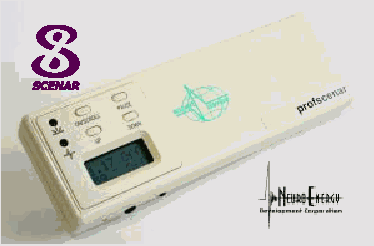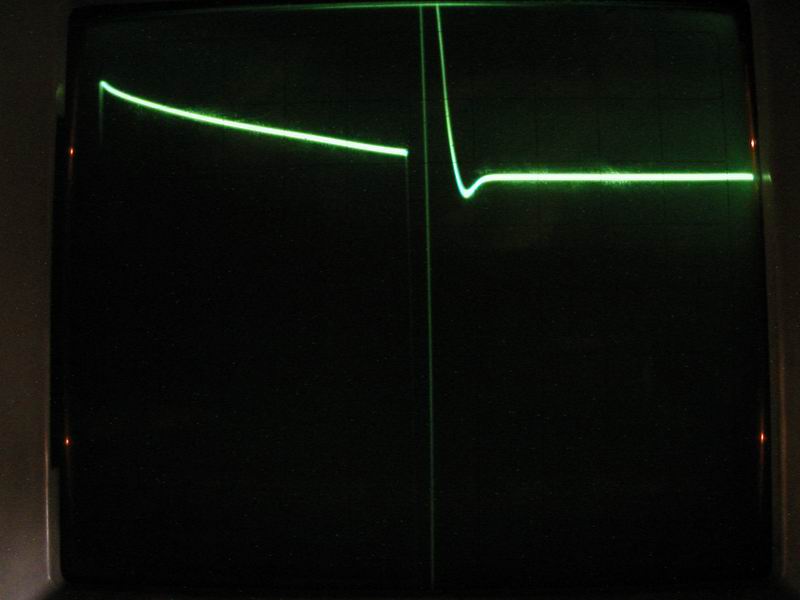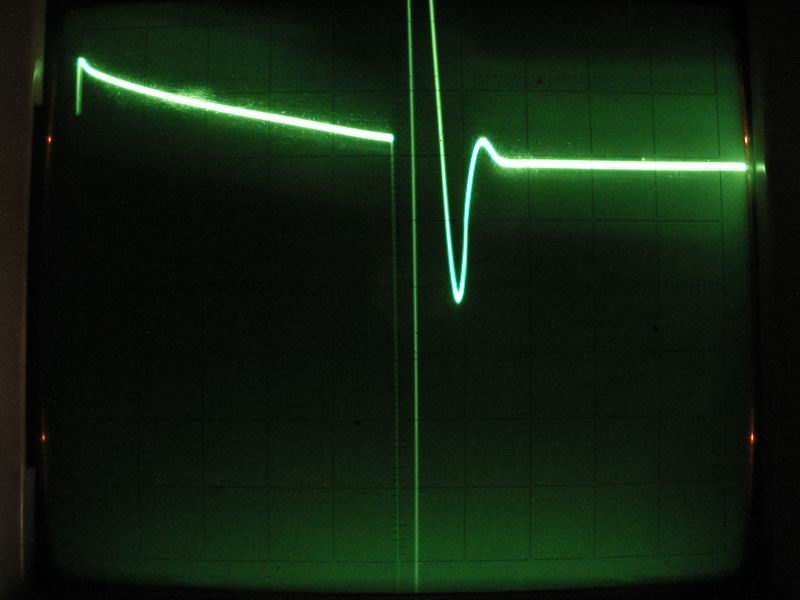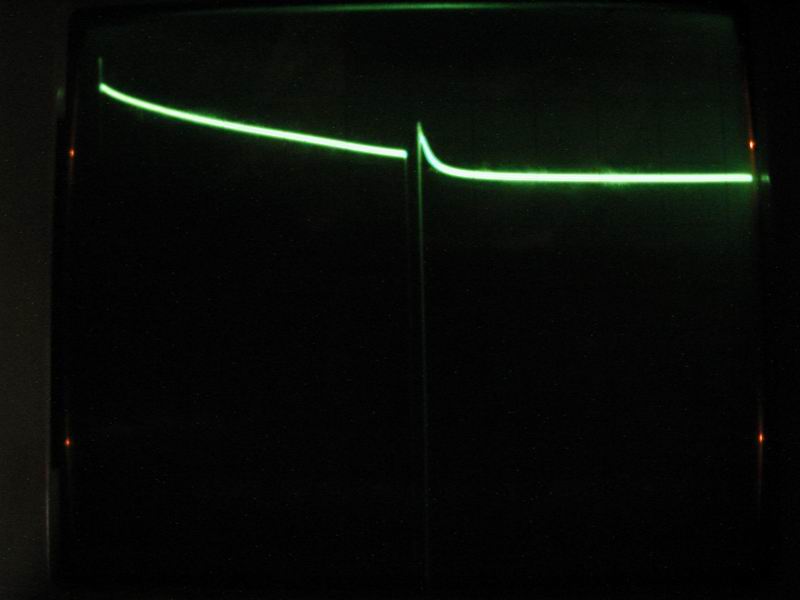|

|
Learning Discoveries
Psychological Services
Where mind and body meet…..
Rosemary Boon Registered Psychologist
M.A.(Psych), Grad. Dip. Ed. Studies (Sch.Counsel),
Grad. Dip. Ed., B.Sc., MAPS, AACNEM. |
|
Telephone:
Sydney (+61 2) 9637 9998
Facsimile:
Sydney (+61 2) 9637 8799 |
Email:
ldps@bigpond.net.au |
Address:
P.O. Box 47
Harris Park NSW 2150
Australia |

SITE MAP
Home / About L.D.P.S & Services Offered / Learning Disabilities / Attention Deficit/Hyperactivity Disorder / The Learning Pyramid /
Articles, Papers & Information Sheets / Classes & Workshops / Related Links & Resources & References / Client Feedback
QUICK JUMPS ON THIS PAGE:-
WHAT IS SCENAR? / DEVELOPMENT OF THE SCENAR / WHO BENEFITS FROM THE SCENAR? / EFFECTIVENESS OF SCENAR THERAPY / HOW DOES SCENAR WORK? / TECHNICAL INFORMATION / WHAT DOES SCENAR THERAPY FEEL LIKE?
/ Special Features of SCENAR Therapy / EFFECTS OF SCENAR ON THE BODY / CONTRAINDICATIONS
/ SCENAR WEB-LINKS / SCENAR REFERENCES

SCENAR THERAPY
(Self Controlled Energo Neuro Adaptive Regulator)
by Gregory J. de Montfort & Rosemary Boon
|
Dynamics
Asymmetry
Combination
Opposites (left) |

|
Stability
Small asymmetry
Alternation
Opposites (right) |
|
|
Cycle |
|
WHAT IS SCENAR?
SCENAR
is an acronym for Self Controlled Energo Neuro Adaptive Regulator. It is a reflex biofeedback device involving no drugs and no surgery, only light touch to the body with an electrical energy corresponding to the body's own signals. The SCENAR is a hand held bio-controlled electro-impulse therapy ideal for pain control in various functional and pathologic processes and helps to correct them by stimulating the body's own healing reserves. It is entirely non-invasive. Tests in Russia have since shown the device to be effective in managing pain in 80% of cases.
DEVELOPMENT OF THE SCENAR
A team of Russian doctors and scientists led by Alexander Karasev and Professor Revenko at Sochi University developed the device in the 1970's. Lying midway between East and West, it is a product of the space race. Both Eastern and Western physicists were encouraged to develop energy medicine at a time when massive funding was poured into research for the American and Russian space programmes.
It was dubbed "the Star Trek Device" by the European Press, after the all-curing energetic medical device used on that popular science fiction series.
In 1986 the SCENAR was permitted by the USSR Medical Council for release to the general public and hospitals. In Russia, there are over 50,000 case reports of the device’s use and some 600 practitioners currently use the device as their principal treatment instrument. A vast wealth of information is available from research papers, clinical reports and training manuals. The Russian Committee for New Medical Technology and the department for "Non-drug Methods of Treatment" have released seven publications on SCENAR Therapy. Eight international conferences as well as 20 inter-regional seminars that have been held to date.

Although the SCENAR is relatively new to Australia, it is approved in England for pain relief, and in May 2002 it received approval from the Food and Drug Administration (FDA) for use as a biofeedback device in the United States.
WHO BENEFITS FROM THE SCENAR?
The SCENAR has been used to assist in pain management and relief in all types of disorders- circulatory, respiratory, neurological, genitourinary, endocrine, musculoskeletal, immune, gastrointestinal and even psychological discomfort. The SCENAR device is particularly effective for various types of organic and referred pain, musculoskeletal pain, and, as evidenced by its use for the Russian Olympians, for acute conditions such as fractures and sprains.
EFFECTIVENESS OF SCENAR THERAPY
It is important to note that the SCENAR does not treat a particular disease or condition
. However, results reported for the SCENAR have been remarkable. There seems to be very few ailment categories that it cannot assist. Improvements in particular conditions are simply the result of applying procedures developed over two decades of the device's use to effect a change in skin/body response to the SCENAR signal/impulse.
Dr Keith Scott-Mumby, writing in "Virtual Medicine" (London: Thorsons 1999), reports the cumulative effectiveness for a variety of disease categories, as follows:
Circulatory 82%
Respiratory 84%
Gastrointestinal 93%
Genito-urinary 89%
Gynecological & Obstetrical 78%
Musculoskeletal 79%
Ear and Mastoid 82%
Eye and Andexae 93%
Mouth/jaw/salivary glands 91%
Russian experience suggests that it is effective in neurological disorders - 81%; skin disorders - 61%; neuroendocrine disorders - 81%; mental and behavioural disorders - 81%.
The device also assists in normalising metabolic processes thus increasing the adaptive ability of the body and greatly reducing recovery times from injury, infection or trauma. These effects can be traced and confirmed by additional methods of investigation: ECG, EEG, X-ray, CT, Ultrasound, irido-diagnostic, biochemical investigations, electro-information investigation, computer acupuncture diagnostics- Nakatani, Voll etc.
HOW DOES SCENAR WORK?
The SCENAR is operated by placing the device directly onto the skin, where it collects electromagnetic signals, records the skin response and uses its sophisticated software to return a freshly modulated and modified signal back to the body.
In an area of pathological focus, the first sign is usually an increased pain sensitivity to pressure; secondly, there is a marked decrease in electrical skin resistance. By sending endogenous biofeedback impulses toward the area of the pathological focus, the SCENAR device can also help the body to identify, 'reconnect and recognise' the pathological area. This allows the person’s own body to release certain chemical substances (regulative peptides) which in turn help to regenerate the damaged cells or to restore the disturbed function.
Every event in the body, either normal or pathological produces electrical changes and alterations of the magnetic fields surrounding the body The electric fields produced during muscle movements are widely considered to provide the information that directs the activities of 'generative' cells such as osteoblasts, myoblasts, perivascular cells, fibroblasts and others that lay down or resorb collagen, thereby 'reforming' tissues so that they can adapt to the way the body is used. (Oschman, 1996).
Since the SCENAR works on the skin surface, stimulating all structures of the skin, it works on the principles of acupuncture and reflex zones. The skin develops embryologically from the same tissue as that of the nervous system. (Please see the article
Stages of Brain Development for further clarification. - Click your browser's "Back Button" to get back to this article). Both reflexology and acupuncture treat areas of the skin that represent internal organs and energy pathways. Therefore, use of the SCENAR influences every system of the body and assists in balancing energy flow of the meridians.
The SCENAR
delivers a "dosage" in the form of bi-polar electrical impulses to stimulate the body via an in-built and/or attached electrodes (there are various attachments to the device enabling various applications) in direct contact with the skin surface, and in accordance with electro-dermal impedance. These impulses have been tailored to mimic the electrical discharges of the nervous system in order to elicit the person's response with optimum efficiency and minimum disruption to cell function. The impulses act on the central nervous system via the ascending pathways of the spinal cord to the cortex of the brain which then conveys impulses to trigger responses in organs corresponding to the area of skin being treated. Additionally, it acts on the peripheral nervous system via the cytoplasm matrix and meridians. The SCENAR impulse by its nature also acts upon the segmental or dermatomal mechanism to act upon spinal reflexes.
In response to the SCENAR impulse, regulative neuropeptides (chemicals released by nerves) are released in cascade, thus instigating a 'whole body' effect - it operates on both mind and body (hence its ability to affect psychological disorders). As Candace Pert said "At any instant or body is in our mind and our mind is in our body". It is the biofeedback function of the SCENAR that provides an individual 'dosing' action via the skin that promotes restoration of the body's disturbed (or lost) function. The "dosage" can be delivered automatically or over-ridden at the discretion of the therapist with guidance from visual, audio and tactile indicators plus digital diagnostic and treatment protocols.
The practitioner determines where to apply the device by looking for anomalies on the skin surface. These anomalies are indicated by redness, numbness, 'stickiness' (a magnetic-like drag as the device is moved across the skin) or a change in sound emitted from the device. Experience indicates that the body's natural healing process is commenced by treating these "asymmetries".
The number of sessions depends upon the unique requirements of the presenting pain - condition - dynamics (or lack of same). The more chronic the condition, the more frequent the SCENAR sessions and the longer the treatment period. Acute conditions usually resolve quickly.
The SCENAR action is aimed at both the "fast" pain blocking A-fibres and the "slow" pain producing and peptide generating C-fibres. The signal stream, comprising waveform, signal strength (voltage and current) and frequency, can be varied in a number of ways, either by pre-selection by the operator or automatically by the control circuitry of the device. Stimulating inhibitory interneurones in the lateral horns of the spinal cord reduces the production of substance P. Exciting interneurones in the posterior horns of the spinal cord causes release of opioid substances. Serotonin is released from the lateral nucleus of the mesencephalon and from the peptide-ergic ventral nucleus of the hypothalamus.
SCENAR impulses applied to the paravertebral zones, reduce the activity of the Renshaw cells (inhibitory interneurons that are innervated by collaterals from motoneurons and in turn form synapses with the same and adjacent motoneurons to exert inhibition
) and therefore, restores the ability of the nervous system to damp down the transmission of pain impulses.
The SCENAR
gives pain relief in three ways:
1) by providing a new signal, dominant focus is formed in the cortex, which causes de-localisation of the previously dominant focus of pain and activates the parasympathetic nervous system;
2) by changing the sensitivity and decreasing the lability in the thick A and thinner C nerve fibres. The faster A fibres depolarise the substantia gelatinosa (glial cells) and pain impulses arriving via the C fibres are prevented from continuing (Gate theory) and
3) by activating cortical and sub-cortical centres to send descending efferent impulses that increase blood flow and stimulate local humoral mechanisms, viz., the production and release of endorphins and increasing the activity of enzymes, such as acetyl cholinesterase, histaminase and kinases.
TECHNICAL INFORMATION
The signal stream, comprising waveform, signal strength (voltage and current) and frequency, can be varied in a number of ways, either by pre-selection by the therapist or automatically by the control circuitry of the device. The maximum current output of the device is 70 mA and the peak voltage is 180v, derived from an internal 9v battery.
Fig. 1 Scheme of the SCENAR impulses



The basic SCENAR signal component is a bipolar pulse, consisting of a negative square-wave followed by a positive saw-tooth, starting and finishing at zero and lasting for a few microseconds - this combination can be altered in many ways.
The significance of the unique SCENAR wave form can be readily seen when you understand that American orthopedic surgeon, Robert Becker in 1958 discovered that a negative electrical current is associated with the regenerative phase of healing. He discovered that it is a direct electrical current (D.C.), of the semiconductor type that is mediated by the nervous system - although not directly. Mediation is achieved by the Schwann cells of the peripheral nervous system as well as the glial cells and ependymal cells of the central nervous system. It is thus a perineural system which is continuous throughout the whole body (connective tissue) and apparently serves as an analogue electrical information system regulating regenerative and healing processes in the body. (By contrast, the nervous system proper is considered to be a digital electrical information system).
With the SCENAR 97.4 devices a number of these pulses may be packaged into a discrete burst (intensity) which itself may be repeated at a fixed default frequency (DF). The individual pulses in these bursts (intensity more than 1) can themselves be spaced out (Z=10/close together, to 80/wide apart) to give a concentrated (deep) or diffuse (shallow) penetration, depending on local body density or depth of pain location.
Alternatively, a single pulse may be pre-selected to a pulse repeat rate (PRP) over a set frequency range. The signal may also be "modulated" either by altering the ratio of "time-on" to "time-off" or by changing the pulse waveform by selecting one of a series of set damping factors. These "modulations" can either be applied individually or together. There is also the possibility of automatically cycling both the pulse repeat rate (PRP) over a set frequency range and the waveform damping factor. These cyclical modes can again be invoked either individually or together.
All of these variants ensure that the therapist has a comprehensive arsenal with which to stimulate both acute and chronic conditions. Use of these variants, enables the therapist to ensure that
every impulse delivered by the SCENAR is different from the preceding input in accord with the input from the person (skin response). This prevents the body from adapting or habituating to the signal before there has been time to generate sufficient neuropeptides (endorphins etc.) to relieve pain and to create an enhanced environment for the person to bring into play their own internal healing pharmacy enabling a shift towards homeostasis.
WHAT DOES SCENAR THERAPY FEEL LIKE?
During a SCENAR session, the recipient feels only a gentle tingle and /or stroking sensation, as the device is moved over the spine, abdomen, infected area or other relevant portions of the bare skin. The SCENAR's signals, in contrast to other electrical therapies, changes in response to body changes, thus preventing adaptation or habituation.
It is this "biofeedback" feature that distinguishes it from TENS machines and others which send out a consistent continuous signal to which the body can eventually fail to respond.
Since SCENAR therapy is aimed at pain relief it can therefore aid to increase energy/vitality; boost the immune system; encourage homeostasis; and reorganise repetitive Central Nervous System patterns or 'loops' (i.e. help re-establish original healthy organism response). This is because once pain is reduced, substance P and cortisol no longer flood the system and the system has a chance to rebalance itself and return to normal functioning.
While the device was originally designed for pain relief and has been approved as such (CE/FDA), by virtue of it's mode of operation, more profound effects other than pain relief have been experienced by clients. These effects are based upon an awakening of the intrinsic healing mechanism - that is, by stimulation of a cascade of neuropeptides; effecting cell and tissue regeneration; providing energy for the healing process.
 Special Features of SCENAR Therapy
Special Features of SCENAR Therapy
- The high amplitude impulses are non-damaging as they
have been tailored to mimic the electrical discharges of the nervous system.
- A feedback mechanism is provided by the constant monitoring of skin impedance, which will change with time and "dosage" delivered
to prevent the body accommodating or 'habituating' to (and thus ignoring) the impulse.
- SCENAR therapy can be given to a person who has active complaints, at any stage of exacerbation. SCENAR is most effective when there is an active process as there is both a focus for working and an active internal communication.
- For chronic conditions, the number of SCENAR sessions depends upon the nature and duration of the complaint.
- The next course of SCENAR sessions begins when/if the complaints reappear or new complaints arise.
- Results of SCENAR therapy may be delayed. Effects of an individual session may continue for 1-3 days afterwards and for a series of consecutive sessions for up to 2 weeks. There is a need only to create change, not necessarily resolution as change is the indication of activation of the body's own healing mechanism.
- The use of a Multilayered Treatment Blanket (MTB)- made from polyurethane interwoven with various metals before and/or after SCENAR treatment aids to screen the body from all external electromagnetic and electrostatic fields while reflecting the body’s own energies back on itself to help it to recuperate. If the MTB is used before a SCENAR session,
asymmetries may appear ready for a treatment. If the MTB is used after the session, it helps the body to integrate the treatment and recover its balance. Maximum effect is achieved when the person is wrapped completely and sleeps.
The attributes of the SCENAR device allows combining in one session, the various effects of electro-analgesia, dia-dymanic current (DDC), short-impulse electro analgesia (SEA) etc. The device can achieve effects which are similar to the effects of electro-puncture. Acupuncture points and reflex zones are at areas of higher enervation (close proximity to nervous trunks, above nervous plexus, lymphatic and blood vessels, at places where a nerve exits/enters the bones). With the high conductivity of these areas, the main energy of the action of the SCENAR device can be applied to them.
It has been suggested that SCENAR-therapy smoothes away the differences between physiotherapy (particularly electrotherapy) and acupuncture, where general mechanisms and actions are similar to each other.
EFFECTS OF SCENAR ON THE BODY
Based on the experience of Russian SCENAR therapists some reflex zones were identified as specific zones on the skin, corresponding to certain organs and systems in the body. Applying the SCENAR device to the particular zones appears to enhance the body's own natural healing mechanisms. This can be easily correlated to the Western concepts of 'dermatomes' and 'spinal nerves'.
The term adaptive reaction is used in SCENAR technology to represent the normal and healthy process where the organism responds to a change. We respond in a healthy state to stress by undertaking 're-creational activities'. The body may respond to an infection by increasing the internal temperature: a programmed adaptive response to a stressor or threat to its wellbeing.
By contrast, in conventional medicine, the adaptive reaction of the organism to a change in its external environment is called a "disease" and the approach is to "fight" with them in order to expel them from the organism. However, an adaptive reaction is not a disease. There seems to be little real sense in fighting these adaptive reactions: it appears to be more constructive to support the natural response of the organism. This is exactly what the SCENAR aims to do - its impulses aim to strengthen the integrity and natural balance of the organism as a whole by stimulating the nervous system to produce neuropeptides. Neuropeptides are chemicals produced by the nerves, that keep the body balanced and reestablishes the body's natural physiological state in which healing is achieved. Without these regulatory neuropeptides, the body adapts and becomes "stuck" in "disease states" and portions of the body are blocked from communicating with the energetic system that keeps it in balance. The SCENAR begins a dialogue with these blocked areas by providing a new stream of information. Once the lines of communication have been reestablished, the information-starved areas keep on "talking".
Furthermore, since these regulatory peptides last up to several hours, the healing process continues long after the treatment session. The net effect is to excite motor and sensory fibres, increase the speed of blood flow, activate local humoral mechanisms and promote the removal of waste products from cells.
Therefore, many other mechanisms of the body are acted upon by the impulse generated by the SCENAR device and these include:- neuro and other regulatory peptides (via cascade release); membranous resonance of the cell (each cell in the body vibrates in it's own way and there is overall resonance in the body); molecular polarisation (molecules reposition themselves within an electrical field); and microphoresis ( It should also be noted, there is a 'mini pharmacy' on the surface of the skin and the action of SCENAR stimulates selective reabsorption of trace elements and minerals - for this reason it is recommended not to bathe or shower for two hours before and after treatment).
Since the SCENAR assists in normalising metabolic processes and thus enhancing the adaptive ability of the body, other reported benefits include improving sleep disturbances, appetite, behavioural problems, learning ability, memory, sexual function and overall physical health. In Russian journals, the SCENAR is also credited with dramatically reducing recovery times. Russian athletes have been known not only to compete after serious injuries, but to then go on to break world-records. In accident and emergency wards, its ability to aid recovery is utilised in Russia to help victims of cardiac arrest, massive trauma and coma. Trials in Russia have proven the SCENAR's application for pain relief. Both cancer and fracture patients have been reported to have found more pain relief from the release of natural opioids after SCENAR treatment than from administered opiates. (In trials in this clinic, most people report clarity of thought, general well-being and ease after a SCENAR session).
CONTRAINDICATIONS
In over twenty years of use in Russia and Europe, no unwanted side effects have been noted. Since the impulses sent by the device are similar to the body's own impulses, these are quite safe, even for children and pregnant women. The peculiarities of SCENAR-therapy means that there are few contra-indications.
The obvious contraindications are cardiac pacemakers and other such electrical implants, individual intolerances, alcohol intoxication and obscure infectious diseases.
With all this in mind, wherever other electrotherapies have effects, SCENAR-therapy will also be useful, and indeed, it has been found to be very useful when other electrotherapies have failed. As with all therapies/methods that stimulate rather than suppress the body's own healing power, the initial effect may be a "healing crises" that makes the person feel worse before feeling better. A lack of energy and general malaise may result as old problems and toxicities are brought to the surface for treatment and elimination. This necessary bit of housekeeping soon passes and is followed by new heights of wellbeing, increased energy and a more refreshing sleep.
 At Learning Discoveries, our approach looks at guiding and educating the person in their own innate capacities to attain balance and wellbeing in their lives. Therefore, synergistic interventions (depending upon biochemical individuality) used in conjunction with the SCENAR at this clinic may include dietary changes, CranioSacral Therapy and Neurofeedback.
At Learning Discoveries, our approach looks at guiding and educating the person in their own innate capacities to attain balance and wellbeing in their lives. Therefore, synergistic interventions (depending upon biochemical individuality) used in conjunction with the SCENAR at this clinic may include dietary changes, CranioSacral Therapy and Neurofeedback.
Appointments for consultation can be made by contacting :-
Rosemary Boon
Registered Psychologist
M.A.(Psych), Grad. Dip. Ed. Studies (Sch.Counsel),
Grad. Dip. Ed., B.Sc., MAPS, AACNEM.
|

|
Learning Discoveries
Psychological Services
Where mind and body meet… |
|
Telephone:
Sydney (+61 2) 9637 9998
Facsimile:
Sydney (+61 2) 9637 8799 |
Email:
ldps@bigpond.net.au |
Address:
P.O. Box 47
Harris Park NSW 2150
Australia |
SCENAR LINKS:
ENLIGHTENED THERAPIES Are the Australian distributors of the ENAR Space Healer, the SCENAR Professional and the Multi-layer Therapy Blanket. Training, certification as well as individual treatments are available.
Located at 2B Nicholson St, Burwood, NSW.
Telephone: (02) 9745 1277 Facsimile: (02) 9745 5033 Email: info@enlightenedtherapies.com
Dr. Keith Scott-Mumby Authour of "Virtual Medicine - A New Dimension in Energy Healing: Discover where Ancient Wisdom meets Breakthrough Technology"
sEnergy Medical Group- Jerald Lee Tennant, M.D.
LET MEDICAL RUSSIA
The SCENAR TRAINING CENTRE LTD
SCENAR WORLD
SCENAR REFERENCES:
1. Grinberg Ya.Z. SCENAR therapy: the effectiveness from the point of view of methods of electrotherapy. SCENAR therapy and SCENAR expertise. Compilation of articles, issue 2, p 18-33. Tangarog, 1996.
2, Grinberg Ya.Z. Question of the substantiation of the effectiveness of SCENAR therapy. SCENAR therapy and SCENAR expertise. Compilation of articles, issue 3, p.17-23. Tangarog, 1997.
3. Bogolubov V.M., Ponomarento G.N. General physiotherapy. M.; compilation 1996 – 480 pp.
4. Revenko A.N. Adaptation –adaptive regulation (SCENAR). Theoretical and practical substantiation.
5. Gorfinkel Yu.V. Theoretical and practical basis for the increase in effectiveness of SCENAR therapy. SCENAR therapy and SCENAR expertise. Compilation of articles, issue 2.
6. Nozdrachev A.D. Physiology of the nervous system. L.: "Medicine", 19238, p.296.
7. Nozdrachev A.D. Chemical structure of the peripheral autonomic (visceral) reflex. Usp.physiol. science, 1996, v.27, No.2, p.28-60.
8. Nozdrachev A.D. Axon-reflex. New point of view in the old area. I.M.Sechenev Physiol.magazine, 1992, v.11, p.135-142.
9. Ashmarin I.P., Kamenskaya M.A. Neuropeptides in the synaptic passage. Results of science and technique. Ser. "Physiology of humans and animals", v.34, 1988, p. 183.
10. Ashmarin I.P., Obuchova M.F. Content of regulative peptides in the brain cortex and their central activity. M. "Highest nervous activity", v.35, No.2, p. 211-221.
11. Osadchyi O.E., Pokrovskyi V.M. Peptidergic mechanism in the parasympathetic regulation of the cardiac rhythm. UFN, v.24, No.3, 1993, p. 71-85.
12. Belyakov N.A., Solovieva I.E., Meshkova M.E. Regulative peptides in the lung. UFN, v.23, No.2, 1992, p.74-87.
13. Babichev V.N. Neuroendocrine regulation of the secretion of gonadotrophins and prolactin and the role of neuromediators in it. UFN, v.26, No.2, 1995, p.44-59.
14. Shandra A.A., Godlevskyi L.S., Tkachenko I.V., Servetskyi K.L. The role of black substance in mechanisms stopping epileptic activity. UFN, v.26, No.2, 1996, p.90-102.
15. Malyshenko N.M., Popv N.S. Hormones and neuropeptides in the integrative processes. UFN, v.21, No.2, 1990, p.94-106.
16. Kaluzhnyi L.P., Heterogeneity of nociceptive and anti-nociceptive peptic mechanisms and their correlation with the genesis of pain. UFN, v.21, No.4, p.68-84.
17. Zavitaev Y.A. SCENAR examples of single SCENAR application. SCENAR therapy and SCENAR expertise. Compilation of articles, issue 2,c.81-82. Tangarog 1996
18. Bogdanova E.P., Zaidiner B.M. Anti-pain SCENAR therapy in oncologic practice.
19. Lyashedko P.P. Usage of bio-regulative electrostimulation in the treatment of complications in the gastro-intestinal tract in patients suffering from sever multiple-injury. SCENAR therapy and SCENAR expertise. Compilation of articles, issue 4, 1998.
20. Oschman (1997): "What is healing energy? Part 3: silent pulses". Journal of Bodywork and Movement Therapies., April.
21. Pert, C. (1997); "Molecules of Emotion -Why you feel the way you feel". Scribner, New York, NY.
22. Frost, Z. & McDermott, D., (2000): SCENAR Training Centre Course Manuals Levels 1 & 2. Cheltenham, UK.
23. Beck R 1986 Mood modification with ELF magnetic fields: a preliminary exploration. Archaeus 4: 48
24. Brown J W 1991 Self and process. Brain states and the conscious present. Springer-Verlag, New York
25. Chopra D 1994 Keynote lecture at Columbia University Dharam Hinduja Indic Research Center Conference, Health, Science, and the Spirit: Veda and Ayurveda in the Western World, 28–29 October, 1994. Conference summary by Hartzell JF and Zysk JG Journal of Alternative and Complementary Medicine 1(3): 297–301
26. Freeman W J 1995 Societies of brains. A study in the neuroscience of love and hate. Lawrence Erlbaum Associates, Hillsdale, NJ Oschman J L 1993 A biophysical basis for acupuncture. Proceedings of the First Symposium of the Society for Acupuncture Research, Rockville, MD, 23–24 January Oschman J L,
27. Oschman N H 1994a Somatic recall. Part I. Soft tissue memory. Massage Therapy Journal, American Massage Therapy Association, Lake Worth, FL 34: 36–45, 111–116
28. Oschman J L Oschman N H 1994b Somatic recall. Part II. Soft tissue holography. Massage Therapy Journal, American Massage Therapy Association, Lake Worth, FL 34: 66–67, 106–116
29. Redpath W M 1994 Trauma energetics. A study of held-energy systems. Barberry Press, Lexington, MA. Available from Guild for Structural Integration, Boulder, CO; tel: (1) 800 447 0150
30. Russek L G, Schwartz G E 1994 Interpersonal heart-brain registration and the perception of parental love: a 42-year follow-up of the Harvard Mastery of Stress Study. Subtle Energies 5: 195–208
31. Russek LG, Schwartz GE 1996 Energy cardiology: a dynamical energy systems approach for integrating conventional and alternative medicine. Advances: The Journal of Mind-Body Health 12(4): 4–24
32. Bassett CAL 1995 Bioelectromagnetics in the service of medicine. In: Blank M. Electromagnetic .elds: biological interactions and mechanisms. Advances in Chemistry Series 250, American Chemical Society, Washington DC, pp 261–275
33. Baule GM, McFee R 1963 Detection of the magnetic field of the heart. American Heart Journal 66: 95–96
34. Becker RO, Marino AA 1982 Electromagnetism and life. State University of New York Press, Albany
HOME
Top of Page





